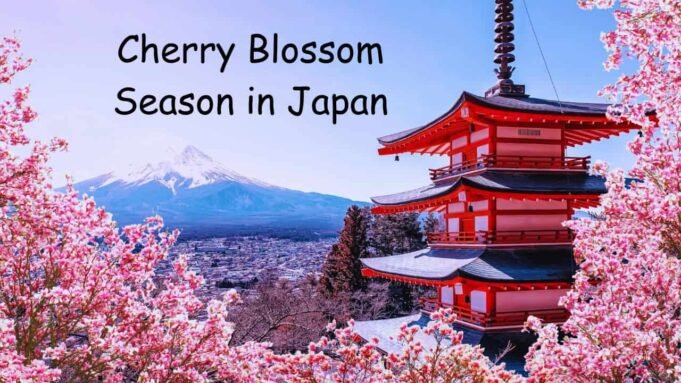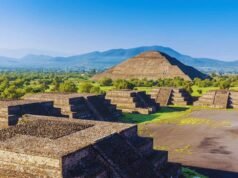When Is Cherry Blossom Season in Japan? – Every spring, Japan bursts into a delicate sea of soft pink and white as cherry blossoms—known locally as sakura—bloom across the country. For centuries, this fleeting display has symbolized beauty, renewal, and the transient nature of life.
The sight of sakura petals drifting gently to the ground inspires poetry, art, and a sense of nostalgia among locals and travelers alike.
During this short yet magical period, streets, parks, riversides, and temples become vibrant gathering places for people to celebrate hanami, the beloved tradition of enjoying the blossoms with friends and family.
When Is Cherry Blossom Season in Japan?
Cherry blossom season in Japan follows a south-to-north blooming pattern due to the country’s varied climate. In the subtropical Okinawa islands, blossoms can appear as early as mid-January, while in Hokkaido in the far north, they bloom in late April or early May.
The majority of mainland Japan—home to cities like Tokyo, Kyoto, and Osaka—sees its peak between late March and early April. Weather conditions in the months leading up to spring, such as temperature fluctuations, significantly influence when the trees will open. This unpredictability is why locals and travelers follow the sakura forecast closely each year to time their hanami plans perfectly.
When Is The Best Time to See Cherry Blossoms in Japan?
The best time to see cherry blossoms depends on where you are in Japan. In most of Honshu—including Tokyo, Kyoto, and Osaka—peak bloom typically falls between the last week of March and the first week of April.
Okinawa experiences blooms much earlier, from mid-January to early February, while Hokkaido’s blossoms arrive later, from late April to early May. Since the exact timing varies each year based on weather patterns, checking the annual sakura forecast is essential for accurate planning.
Related: Beauty of Japanese Cemetery Park
The Tradition of Hanami
Hanami, which translates to “flower viewing,” dates back over a thousand years to Japan’s imperial courts. Originally a pastime for aristocrats, it evolved into a beloved cultural event for people of all walks of life. In its earliest form, hanami involved admiring the blossoms while composing poetry.
But today it often means spreading out picnic blankets under blooming trees, enjoying seasonal foods, and sharing drinks with loved ones. Hanami can take place during the day for a lively picnic or at night under illuminated blossoms—known as yozakura—for a more romantic and serene atmosphere.
Best Places to See Cherry Blossoms
Japan offers countless cherry blossom viewing spots, each with its charm. In Tokyo, Ueno Park boasts thousands of trees lining broad walkways, creating a tunnel of blossoms, while Shinjuku Gyoen blends manicured gardens with wide lawns for relaxed picnics.
Kyoto offers a historical touch, with the Philosopher’s Path leading visitors past temples and shrines framed by flowering branches, and Maruyama Park hosting its iconic illuminated weeping cherry tree. Osaka Castle Park offers a dramatic blend of historic architecture and seasonal beauty, while in Hokkaido, Goryokaku Park’s star-shaped fort surrounded by cherry trees creates an unforgettable aerial view.
Cherry Blossom Season in Japan -Regional Blooming Schedule
Japan’s cherry blossom wave begins in the far south and slowly moves north over several weeks:
- Okinawa: Mid-January to early February
- Kyushu & Shikoku: Mid- to late March
- Honshu (Tokyo, Kyoto, Osaka): Late March to early April
- Tohoku (Sendai, Aomori): Mid- to late April
- Hokkaido: Late April to early May
This gradual shift means that travelers with enough time can follow the bloom northward, experiencing multiple hanami locations in a single trip.
READ: Time Difference Between California and Japan
Cherry Blossom Season Japan 2025
In 2025, Japan’s cherry blossom season is expected to follow its usual south-to-north pattern, with Okinawa’s blooms beginning as early as mid-January and Hokkaido’s blossoms arriving in late April to early May. For most of the country—including Tokyo, Kyoto, and Osaka—peak bloom is predicted between late March and early April.
Weather conditions in the preceding winter and early spring will influence exact timings, but forecasts indicate a slightly earlier bloom in some regions due to mild winter temperatures. Travelers planning to visit in 2025 should monitor the official sakura forecast and book accommodations early, as this is one of the busiest and most celebrated travel periods in Japan.
Cherry Blossom Season Japan 2026

While exact dates for 2026 are not yet officially forecasted, cherry blossom patterns tend to remain consistent, starting in Okinawa in January and sweeping northward through the country until early May. Visitors aiming for Tokyo, Kyoto, or Osaka can expect blossoms to open in the last week of March and reach full bloom by the first week of April, barring unusual weather shifts.
Planning for 2026 should follow the same advice as any sakura season: book early, keep an eye on annual forecasts, and have flexible travel dates to adapt to nature’s schedule. Since cherry blossom season coincides with school holidays and local hanami gatherings, popular parks and scenic spots will be lively and full of atmosphere.
Read More: Top Traditional Museums in Korea and Japan
How Long Do Cherry Blossoms Last in Japan
Cherry blossoms in Japan have a fleeting beauty, with each tree’s peak bloom typically lasting about one week. The most spectacular period—when the blossoms are fully open and petals begin to fall—often lasts only two to three days, depending on weather conditions. Rain and strong winds can shorten the season considerably, while cooler temperatures may help the flowers stay vibrant a bit longer.
On a national scale, the overall cherry blossom “season” stretches from January in Okinawa to early May in Hokkaido, but in any one location, visitors have only a short window to catch the trees at their best. This brevity is part of the cultural charm, reflecting the Japanese appreciation for the fleeting nature of beauty.
What to Eat and Drink During Hanami?
Food is an essential part of the hanami experience. Seasonal treats such as sakura mochi—a sweet rice cake filled with red bean paste and wrapped in a salted cherry leaf—are popular picnic staples. Savory bento boxes packed with sushi, fried chicken, and tamagoyaki (sweet rolled omelet) are common, alongside colorful skewers of hanami dango, small rice dumplings in pastel shades of pink, white, and green.
To drink, many opt for sake or green tea, and in recent years, cafés and convenience stores offer sakura-flavored lattes, sweets, and even beer.
Travel Tips During Cherry Blossom Season
Cherry blossom season is one of Japan’s busiest times for domestic and international tourism, so planning is essential. Book accommodation and train tickets weeks or even months in advance. Arrive early in the day to secure a good picnic spot in popular parks.
If you prefer a quieter experience, consider visiting lesser-known spots such as rural riversides or small town parks. Using the sakura forecast can help you arrive in a city right when the blooms are at their peak—full bloom typically lasts about one week, with the most photogenic days often being just two or three.
- Plan early: It’s peak tourist time, so book accommodations and trains in advance.
- Use forecasts: Follow JMC predictions and mobile apps to time your visits.
- Avoid crowds: Visit parks early in the morning or seek off-the-beaten-path spots.
- Combine with festivities: Seasonal festivals and cultural events add flavor to your hanami.
- Capture the fleeting bloom: Full bloom lasts about one week, and the peak lasts around just 2–3 days.
Read Also: Best Places to Ski in Hokkaido, Japan
Cultural Significance
In Japanese culture, cherry blossoms represent the philosophy of mono no aware—an awareness of life’s impermanence and the beauty found in fleeting moments. Just as the blossoms last only a short while before scattering in the wind, they remind people to cherish the present and accept the passage of time.
This symbolism has influenced centuries of Japanese poetry, painting, and literature, making the sakura season as much a spiritual experience as a visual one.
How Long Do Cherry Blossoms Stay In Bloom?
In a single location, cherry blossoms usually last for about one week once they reach full bloom. The most picturesque days—when the petals are fully open and just starting to fall—are often limited to just two or three days.
Rain or strong winds can shorten this window, while cooler temperatures may extend it slightly. This short lifespan adds to their cultural significance, symbolizing the fleeting nature of beauty and life.
Where Are The Best Places To View Cherry Blossoms In Japan?
Japan is filled with incredible cherry blossom spots, but some of the most famous include Ueno Park and Shinjuku Gyoen in Tokyo, Maruyama Park and the Philosopher’s Path in Kyoto, Osaka Castle Park in Osaka, and Goryokaku Park in Hokkaido.
For iconic postcard views, the Chureito Pagoda with Mount Fuji in the background is a must-see. Smaller towns and rural areas also offer stunning displays, often with fewer crowds and a more relaxed hanami atmosphere.
Is Japan Crowded During Cherry Blossom Season?
Yes, cherry blossom season is one of Japan’s busiest travel periods. Parks, temples, and riversides in major cities attract large numbers of visitors, including locals enjoying hanami picnics. To avoid the heaviest crowds, consider visiting early in the morning, on weekdays, or at lesser-known spots. Traveling to smaller towns or rural areas can also provide a more peaceful viewing experience without sacrificing beauty.
To Know More: What You Need to Know Before Visiting Japan?
Do I Need To Book In Advance For Cherry Blossom Season?
Absolutely. Cherry blossom season coincides with school holidays and local festivals, so hotels, trains, and flights book up quickly. It’s best to secure accommodations several months in advance—especially in popular cities like Kyoto and Tokyo. Having flexible travel dates can also help you adjust to bloom variations and secure better deals.
Conclusion
Cherry blossom season in Japan is more than a natural phenomenon—it’s a cultural celebration that unites history, tradition, and community spirit. Whether you’re wandering through Kyoto’s temple-lined streets, enjoying a picnic beneath Tokyo’s pink canopies, or traveling north to catch the final blooms in Hokkaido, the experience captures the heart of Japan. It’s a reminder that beauty is fleeting, but the memories you create during hanami can last a lifetime.
















[…] lovers will find seasonal beauty in cherry blossoms, autumn foliage, and tranquil winter landscapes, while cultural enthusiasts can enjoy tea […]
[…] to Kyoto depends on your preferred experiences. Spring (late March to early April) is famous for cherry blossoms, with Kyoto’s temples and parks blanketed in pink. Autumn (mid-November) offers vibrant foliage, […]
Comments are closed.